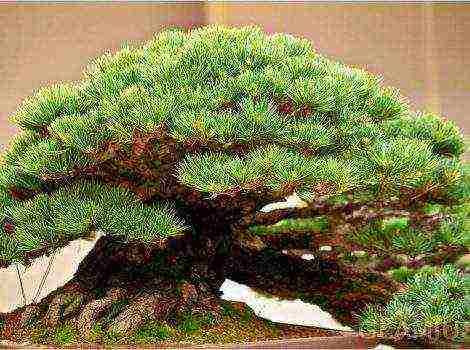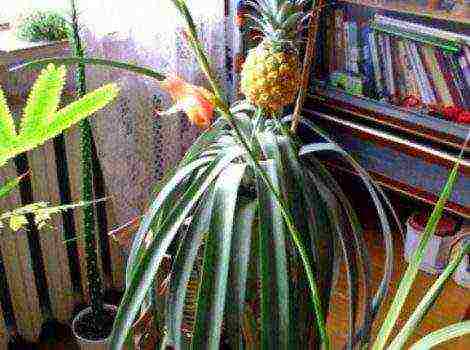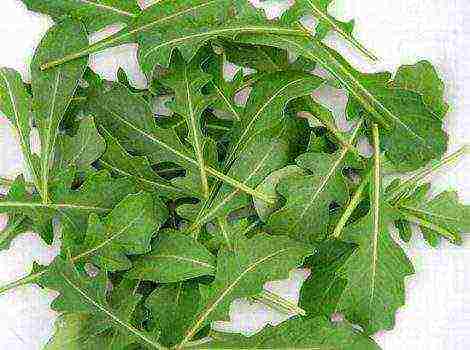Content
 A coconut tree growing in a large tub looks very exotic. Complements any interior, presenting a striking accent. But in order to grow it at home, you need to know the features of caring for this plant. Consider how to plant a coconut tree in a flowerpot, the nuances of its reproduction. In the article you will find detailed descriptions of the stages of growing and photos of the plant.
A coconut tree growing in a large tub looks very exotic. Complements any interior, presenting a striking accent. But in order to grow it at home, you need to know the features of caring for this plant. Consider how to plant a coconut tree in a flowerpot, the nuances of its reproduction. In the article you will find detailed descriptions of the stages of growing and photos of the plant.
Forms, varieties and varieties
The coconut tree is the only member of the Coconut genus. In its natural environment (tropics and subtropics), many varieties of this plant grow. For example, subspecies of walnut coconut:
- viridis with green fruits;
- tall - typica;
- dwarf forms - nana.

Coconut tree in vivo
Ornamental low-growing palms have also been bred, yielding inedible yellow fruits. Varietal forms have nuts of various shades, the most common are:
- Brown.
- Green.
- Orange.
- Yellow, etc.
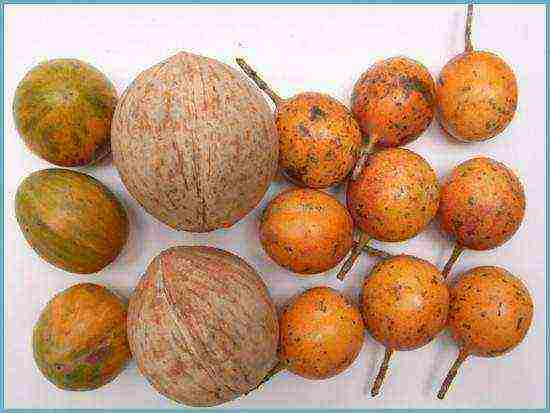
Types of coconuts
The variety of appearance of coconuts can be found in the photo. Fruits differ not only in color, but also in shape; they can be oval, drop-shaped, round, pear-shaped, elongated, etc. The size of the nut and kernel inside it also directly depends on the variety.
Important. In nature, the coconut palm reaches 30 m in height. But at home, it will grow no more than 6 m. To grow in a tub, you must try to find a specially bred undersized form that can please the eye for many years. Whereas a tall species will live at home for no more than 7 years.
Coconut tree propagation, germination and planting
Reproduction takes place by seeds, i.e. the fruit of the coconut tree itself sprouts. For planting, only a walnut covered with a shell is suitable. Peeled coconuts are sold in stores. The top layers, exocarp and coir, are always removed before the product reaches the counter. This valuable raw material is used in industry.

Planting a coconut
To get a coconut tree sprout, you need to have a ripe fruit that has not been processed. The photo clearly shows what a viable nut looks like. Coconuts sprout best with a large supply of juice inside. If you shake it, you can hear a gurgle. Before planting, the fruit must be soaked in water for at least 2-3 days. This creates conditions that are as close as possible to the natural environment when he floats in the ocean.
Important. Coconuts have been able to travel the ocean for over a year. At the same time, their ability to germinate is not lost. And as soon as the wave hits the fruit on the sandy shore, a sprout will appear.
Coconut will hatch only at temperatures around 30 ° C. The air humidity should also be high. This is a very lengthy process, it may take up to six months. Suitable conditions for germination can be created in a greenhouse or greenhouse. After the sprout appears, the fruit is placed in a tub of soil. Only the lower part is covered with the substrate, and the top of the nut should be above ground level. Simulating natural conditions. In their natural environment, coconut trees grow well on sand, but they can thrive on other soils.
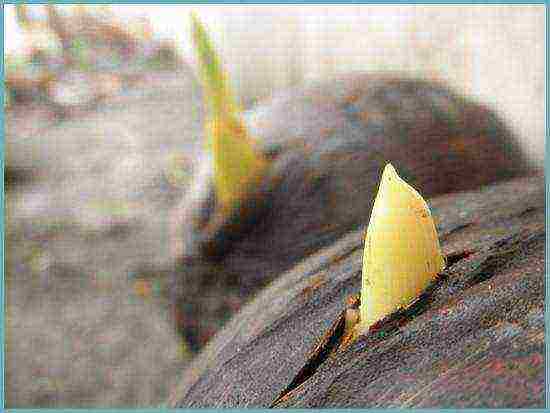
Coconut tree sprout
For home cultivation, the substrate should be soft and loose. It is good to use a universal flower primer, 1: 1 diluted with coarse sand. You can add peat and humus.The optimal diameter of the planting container is about twice the size of the fruit itself. It is imperative to arrange a drainage layer and holes for excess moisture to escape.
Sprouting a coconut requires patience and special conditions. If there is no desire to do this, then you can always purchase a young plant of an ornamental variety in the garden center.
Care features
It is imperative to keep this tropical plant in a well-lit place. But it is advisable to protect it from exposure to direct sunlight, since with their constant exposure, the leaves curl and dry out. A spacious, bright hall or balcony, slightly shaded if it faces the south side, will do. In rooms where there is not enough light, you will have to additionally artificially illuminate a young palm tree. The temperature should not drop below 15 ° C, colder conditions threaten the palm of death.

A constant moisture level is very important for a plant.
The plant needs moist air, ideally 75%. The heating system drains him greatly. Therefore, in winter, they provide additional humidification of the air in the room. When spraying, you need to try so that water does not fall on the nut, but only irrigates the leaves.
Constant watering is vital for the coconut tree. Indeed, at home, it grows on the coasts of the seas and oceans. The earthen coma should not completely dry out. A young plant, especially if it is in a clay pot, is watered every day. The first 3-4 years require annual transplants. When placing a palm tree in a new, more spacious container, you need to save an earthen ball. At the age of 5 years or more, instead of transplants, high quality humus is added to the soil surface.
Important. Pruning is an essential part of caring for a coconut tree growing in a tub. Remove broken, dried leaves. But the leaf plates that have changed their color, darkened or somewhat yellowed are left. Since the plant draws out the necessary nutrient compounds from them.
Fertilizers, top dressing, typical diseases and pests
The coconut tree grows very slowly and uses up large amounts of nutrients. And although from a biological point of view, the plant is undemanding to the composition of the soil, due to the lack of space at home, it must be fertilized. For this, it is recommended to use organic substances. For best results, it is best to feed every month.
It is advisable to start fertilizing in the spring. Continue to do this regularly throughout the summer. And in the fall, gradually reduce feeding so that they would be stopped in winter. During this period, it is better to leave an adult plant alone, reducing not only nutrition, but also irrigation.

For the development of a palm tree in an apartment, the plant needs regular feeding
Insufficiently careful and thoughtful care of the plant provokes the onset of diseases. Excessive watering contributes to the development of fungal infections, under the influence of which the root system can rot. In a potted culture, the coconut tree is affected by a number of pests, the most common of which are:
- Shields;
- Spider mites;
- Mealybugs;
- Thrips;
- False shields.
To combat these insects, insecticides are used, the use of which is permitted indoors.
Growing and caring for a coconut tree at home is quite laborious and time-consuming. But having received a healthy, beautiful specimen, you can rightfully be proud of it. Such an exotic plant is extremely attractive, decorative and unusual. It will surely amaze guests and delight the hosts.
How to grow a palm tree in your home: video
Growing a coconut tree: photo



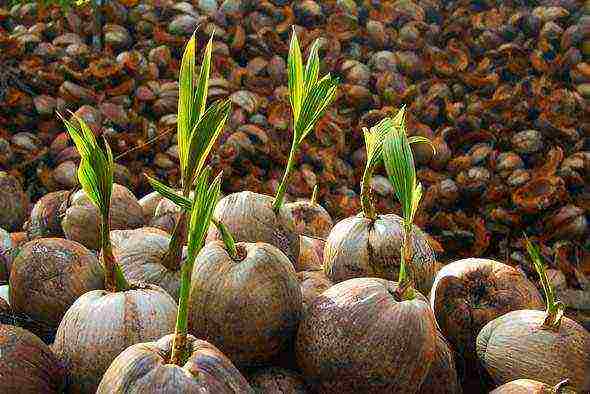
Coconut palm Is a large, tree-like plant that is intensively cultivated in the tropics.The palm tree grows very quickly, the nuts it gives are used for food, it is a very important agricultural crop. Coconut is widely distributed all over the world, and even in the outback of Russia it is very easy to find it in a decent supermarket. The most curious, of course, will want to grow a potted coconut palm. It turns out that getting an indoor coconut is not so easy ...
How to grow a coconut tree?
* Choosing the right coconut.
In order to germinate a coconut, it is important to select quality planting material. Ordinary "edible" nuts from the store will not work, since all protective fibers are removed from them, which prevents them from germinating. Fresh coconuts that have fallen from a palm tree sprout ideally. It is important that the coconut is ripe, juicy and healthy looking. You can bring them from your vacation or order them online.
* Planting homemade coconut.
- In nature, before sprouting, coconuts tend to lie near the surf line, swim in water and are saturated with moisture. We should simulate this situation by soaking the coconut in soft water for 2-3 days. The water needs to be changed daily and, if possible, the coconut should be turned so that the entire shell is evenly soaked. This will help the sprout of the future palm tree to break through more easily.
- For planting, a small pot is suitable, 2 times larger in diameter than the nut itself. The pot should have many drainage holes. The substrate can be used ready-made, floral, it is important to create a drainage layer at the bottom of the pot.
- When planting, the coconut is easiest to place in a supine position, on its side. It can also be buried in the soil with a blunt end, leaving 1/3 of the total length above the ground.
- For the emergence of seedlings, it is important to warm +30 degrees, sunlight and high humidity. The coconut can be hidden by creating a translucent greenhouse where a lot of condensation will collect. The soil should be kept moist and careful not to develop mold or musty odors.
- Coconut sprouts for a long time, from three months to six months. This is due to the fact that the nut shell is very dense and it takes such a period of time for life to begin inside.
* Caring for a coconut tree at home.
At home, it is very difficult to create conditions close to tropical. Our air is dry, and apart from a humidifier, nothing will help to establish a decent humidity. If you do not have a device, spray the palm tree more often, put wet expanded clay in the pan.
The coconut palm is grown in a bright, well-lit area. If this is a southern window, do not forget to shade during peak solar activity. In summer, the plant grows well in the open air.
Coconut grows at room temperature all year round. If the indicators fall below +15, the plant may just get sick!
With the growth of the palm, a transplant will be required. The pot must be increased by transferring the nut by transshipment, without destroying the earthen lump. After a year, light humus fertilizing can be added to the substrate.
Unfortunately, the living environment significantly limits the life resources of the coconut tree. The plant cannot properly grow roots, develop, bear fruit, and at the age of five usually begins to wilt and soon dies. If you are very lucky, you can find homemade coconuts of special varieties suitable for indoor growing in flower shops or at specialty exhibitions.
Either way, the experience of sprouting a coconut and observing the life of a tropical coconut tree is very interesting. It can be a long-term creative project for a child, or just an unforgettable experiment for you!
MAY BE INTERESTING:
Avocado
Banana
Lemon Tree
Garnet
Fig
Lovers of coconut can be envied and sympathetic at the same time. Envy, because from this product they will receive most of the vitamins and nutrients necessary for the body. But, unfortunately, not always in our stores there is a tropical nut that is fit for consumption.Often, due to long-term transportation, already overripe or dried coconuts end up on the shelves. Of course, even if you know how to grow a coconut at home, this problem cannot be solved. But getting a beautiful palm tree is possible.
This is a rather complicated and time-consuming process, but it is still possible to do it. The main snag is where to find a coconut to plant. The fruits sold in the store are not suitable for this. They are, most often, already cleared of the fibrous membrane and therefore will not sprout. Ideally, it should be a nut that has fallen from a palm tree and is immediately delivered to you. Try to contact specialized stores or firms.
When the coconut is picked, proceed directly to growing. A coconut tree will grow at home only if you follow the instructions. Then you will soon be able to enjoy delicious coconut grown with your own hands.
Nut preparation
Before planting a coconut, it must be sent to a container filled with water. The nut should stay there for 2-3 days. Thus, you will bring the fruit closer to natural conditions, because often, before getting to the ground and sprouting, a palm nut floats in the ocean. Also, the water will soften the fibrous membrane, and the coconut will sprout faster.
Pay attention to the container in which you will plant. It should not be very deep, but have a large diameter: twice the size of a nut. Make drainage holes for the coconut to breathe. A flower mixture supplemented with sand is suitable as soil.
Planting a coconut
Take a pot and pour a small layer of expanded clay on the bottom, then mix the earth with sand and make a depression for the fruit. A coconut palm tree at home can be planted in two versions: vertically and horizontally.
In the first case, notice the blunt end of the nut. This is where it was attached to the palm tree. Place the coconut this side down and bury 2/3 of the fruit in the ground. For the second option, place the coconut on its side and compact the soil around it.
The sprout does not appear too quickly, it will take 3-6 months. If you don't want to wait so long, get a sprouted palm tree in the store. This will save you a lot of time.
Care features
The correct temperature regime must be observed. For such a tropical plant, the ideal temperature is 30 degrees. It is also advisable to create a mini greenhouse. Cover the coconut with a material that allows light to pass through. Maintain soil moisture at all times, but at the same time, make sure that the water does not stagnate.
A coconut tree at home should be well lit, but not in direct sunlight. The ideal option is a window on the south side, which has a light shade. When the palm tree has sprouted enough, transplant it into a larger pot. Do not completely shake the soil in which it grew from the nut. Simply transfer it to a new container and add more soil.
A palm tree grown on a windowsill will not bear fruit, but will become a wonderful element for interior decoration. The tree grows for about five years and acquires quite impressive dimensions during this time. Then it dies, but if you take proper care of it, you can extend its life for several more years.
Coconut Tree: Video
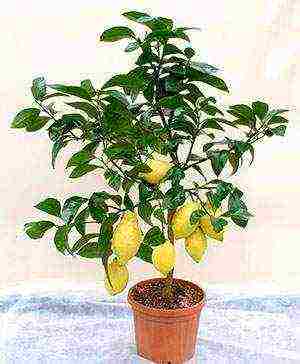 Many types of citrus fruits grow well at home. But how to grow a lemon from a seed, which would not only decorate the room with leathery dark green foliage, but also bear fruit?
Many types of citrus fruits grow well at home. But how to grow a lemon from a seed, which would not only decorate the room with leathery dark green foliage, but also bear fruit?
It is the lack of ovaries on grown plants that often disappoints home citrus growers. Indeed, in the best case, from the moment of planting to the flowering of an indoor lemon, it takes from 4 to 7 years. And yet, getting a lemon from a seed is an exciting and not a futile exercise.A strong tree can be used as a rootstock by grafting a stalk of a cultivated specimen on it, or push it to fruiting with competent care and crown shaping.
If you are going to grow a lemon from a seed at home, you need to be patient and have some knowledge.
The main mistake of indoor plant lovers who have failed in growing lemon or other citrus fruits is that they used seeds that had been extracted from the fruit long ago and that had time to dry out for sowing.
It is much more correct to remove the seeds from ripe fresh lemons, rinse them with warm water and embed them in the substrate immediately, without drying. This will greatly increase the number of seedlings.
Experienced citrus growers recommend another way to increase the speed and quality of germination. To do this, wet lemon seeds intended for growing at home are gently freed from the hard surface shell with a sharp knife, which is the main obstacle to the sprout hidden in the seed.
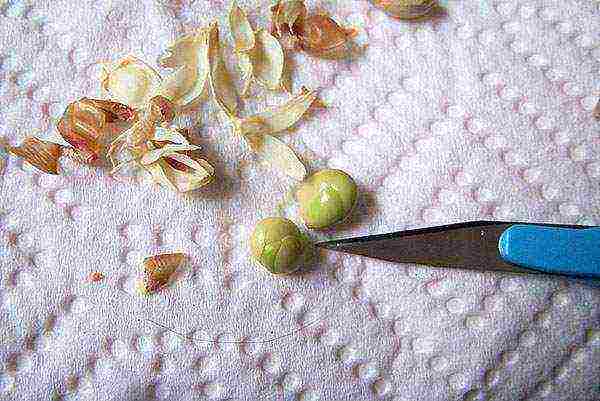 Following this advice, you need to be extremely careful and careful. Wrong movement threatens to damage the cotyledons or a tender embryo, and then the lemon will definitely not appear from the seed.
Following this advice, you need to be extremely careful and careful. Wrong movement threatens to damage the cotyledons or a tender embryo, and then the lemon will definitely not appear from the seed.
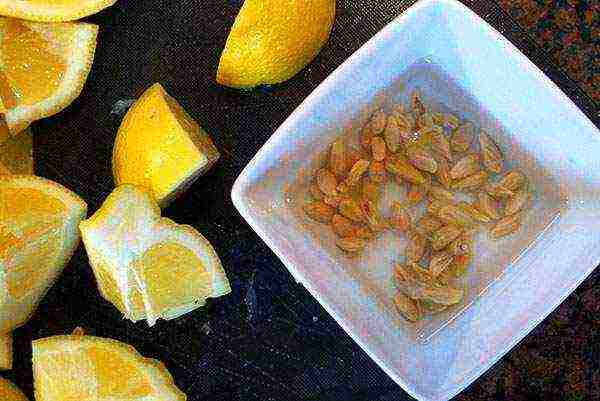 If lemon seeds remain in the shell, it is useful to immerse them in a growth stimulant solution for several hours, preventing the surface of the seeds from drying out between processing and planting.
If lemon seeds remain in the shell, it is useful to immerse them in a growth stimulant solution for several hours, preventing the surface of the seeds from drying out between processing and planting.
Growing lemon from seed at home
Before planting lemon seeds, choose shallow wide containers with mandatory drainage holes. A 2-centimeter layer of fine expanded clay or vermiculite is poured onto the bottom of a pot or other container so that all excess moisture, dangerous for delicate roots, does not linger and leave the ground in time.
You can make your own soil for growing lemon from seed at home by mixing garden soil, humus and sand. It is useful to add a little crushed charcoal to such a substrate, which will reduce the risk of developing bacterial infections. If you don't have the right ingredients on hand, a ready-made citrus substrate, which is easy to buy at a specialty store, will do.
 All preparatory work has been done. Now it's time to start sowing. How to grow a lemon from a seed at home?
All preparatory work has been done. Now it's time to start sowing. How to grow a lemon from a seed at home?
The best sowing time is at the end of winter. Then the sprouted sprouts will receive good support in the form of increasing daylight hours.
The seeds are buried in moist soil to a depth of about two centimeters. Several seeds can be planted in one container at once. Since the seedlings are waiting for the first transplant, when 3-4 true leaves appear on them, the plants will not interfere with each other.
The containers are placed in a greenhouse or placed in a warm place, previously covered with a bag or film. Do not forget that all citrus fruits are thermophilic, therefore, it is possible to grow a lemon from a seed at home only if a certain temperature regime is observed.
 Seedlings will not start growing if the air and soil in the room are colder than +18 ° C. It is optimal if seed germination and subsequent growth takes place at a temperature of 22 to 25 ° C, with constantly high humidity, the absence of drafts and other negative factors. Compliance with simple rules on how to grow a lemon from a seed allows you to get friendly strong shoots.
Seedlings will not start growing if the air and soil in the room are colder than +18 ° C. It is optimal if seed germination and subsequent growth takes place at a temperature of 22 to 25 ° C, with constantly high humidity, the absence of drafts and other negative factors. Compliance with simple rules on how to grow a lemon from a seed allows you to get friendly strong shoots.
On average, from sowing to the moment the shoots appear, it takes from a week to a month. During this time, the soil in the pot can be carefully sprayed, but it should be watered only when there are obvious signs of drying out.
 With the appearance of green shoots above the soil surface, they gradually begin to accustom them to room conditions, ventilating and opening the greenhouse. When 3-4 leaves appear from the seed on a young lemon, the film is removed altogether, and the seedlings are sorted and transferred into their own small pots.
With the appearance of green shoots above the soil surface, they gradually begin to accustom them to room conditions, ventilating and opening the greenhouse. When 3-4 leaves appear from the seed on a young lemon, the film is removed altogether, and the seedlings are sorted and transferred into their own small pots.
Since the seeds of hybrid fruits do not always carry parental characteristics, citrus growers seeking to get a lemon from the seed at home run the risk of growing wild.
To understand how soon the tree will begin to bear fruit, and what quality the ripe fruits will be, it is possible already by external signs. First of all, cultivated citrus trees are distinguished by a small number of thorns on the shoots.
Further care in the first year of seedlings consists in timely watering, transplanting and pinching for the initial formation of the crown of the future tree. 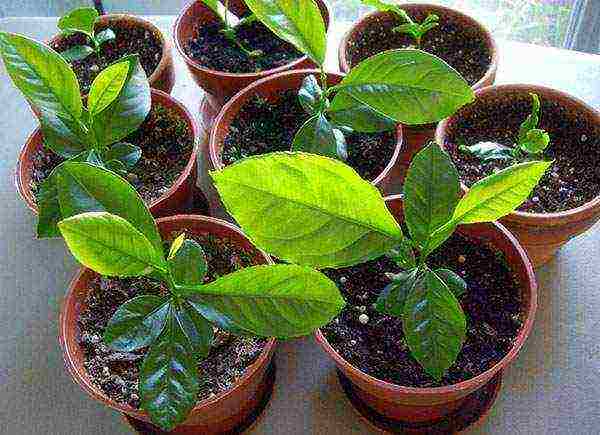 In addition, plants:
In addition, plants:
- in the summer months, after 10-14 days, they are fed by alternating a solution of humus and liquid mineral fertilizers;
- on cloudy days and in the cold season, they are additionally illuminated using fluorescent or LED phytolamps.
The duration of illumination largely affects the flowering and fruiting of plants from the tropical zone. Therefore, the purchase of such lamps should be taken care of before growing a lemon from a seed.
A transplant for young lemons is carried out annually, and the plant should be transferred very carefully, without disturbing the root system. If the roots have not yet mastered the entire earthen ball, you can do with replacing the surface layer.
 Interested in how to grow a lemon from a seed, many enthusiasts look forward to the shoots first, and then the first flowers. But in order not to weaken the plant, the lemon should not be allowed to bear fruit until it is 2-3 years old. The seed lemon ripens for flowering when there is only one flower per 15 leaves of its crown.
Interested in how to grow a lemon from a seed, many enthusiasts look forward to the shoots first, and then the first flowers. But in order not to weaken the plant, the lemon should not be allowed to bear fruit until it is 2-3 years old. The seed lemon ripens for flowering when there is only one flower per 15 leaves of its crown.
If the earlier formation of the ovary weakens the tree, then pinching at the age of about a year only contributes to the formation of the crown and will lay the foundation for future good yields. Therefore, in a very young plant, it is necessary to remove all shoots directed deep into the crown, pinch the tops of excessively long shoots, and also sometimes turn the pot with a tree so that it illuminates and develops as evenly as possible.
Part 1. Planting seeds
> Part 2. The appearance of the first shoots
> Part 3. Transplanting seedlings
>
